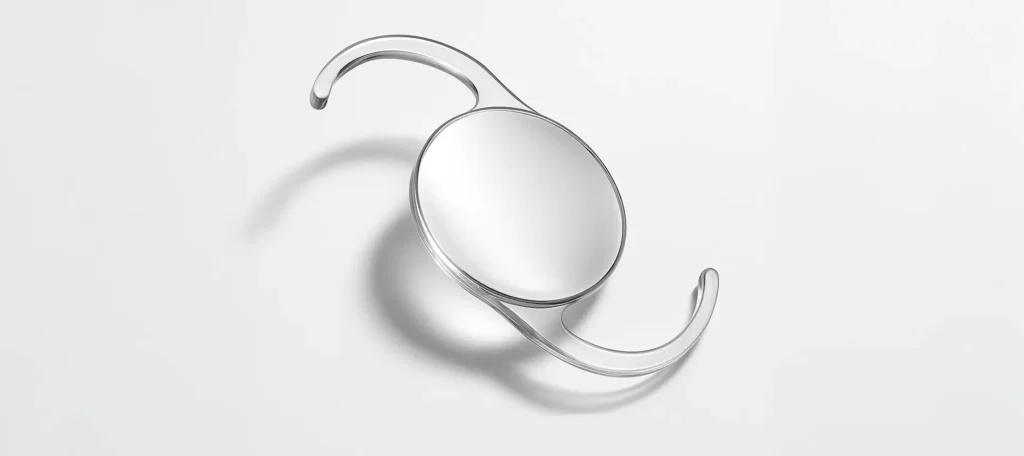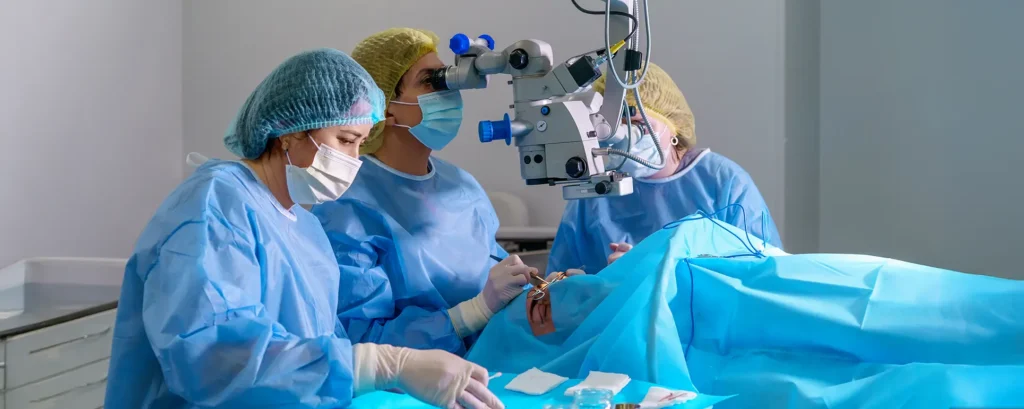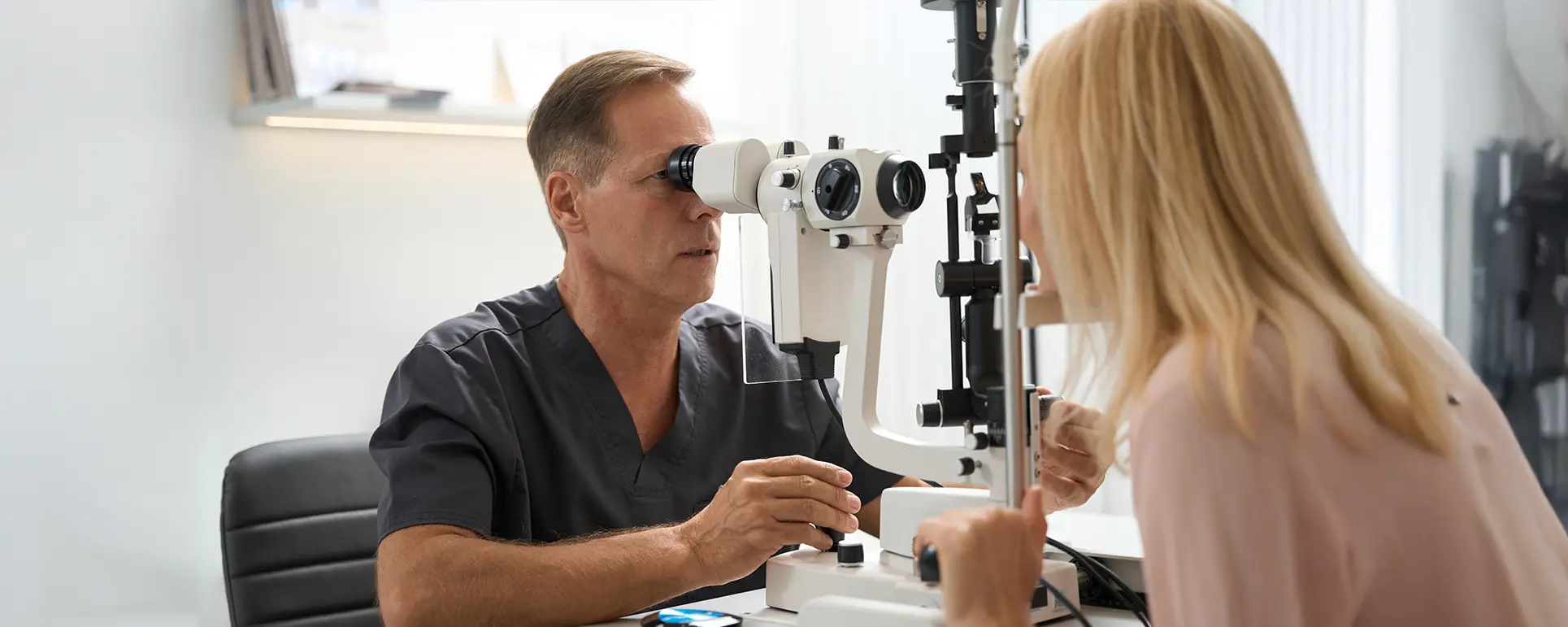If you’ve had an implantable collamer lens (ICL) fitted to correct your eyesight, you may be wondering what happens if you later develop cataracts. It’s a fair question. The natural lens of your eye is still in place after an ICL procedure, so it remains vulnerable to age-related changes like cataract formation. Cataracts are very common, and sooner or later many ICL patients find themselves facing the possibility of cataract surgery.
The short answer is that yes, cataract surgery can be done in an eye that already has an ICL. However, the process is more involved than a straightforward cataract procedure. The surgeon needs to remove the ICL safely, protect delicate structures in your eye, and then replace your natural lens with a new intraocular lens (IOL). This article will guide you through the whole topic: how cataract surgery works when an ICL is present, what adjustments are required, what the risks are, and what outcomes you can realistically expect.
What is an ICL?

An ICL, or implantable collamer lens, is a type of permanent contact lens placed inside the eye to correct vision. Unlike LASIK or PRK, where the cornea is reshaped, the ICL sits just behind the coloured part of your eye (the iris) and in front of your natural crystalline lens. Surgeons sometimes call this a “phakic lens implant” because your natural lens is left intact.
The main reason people choose an ICL is because it offers excellent vision correction for high degrees of short-sightedness, long-sightedness, or astigmatism, often in cases where laser eye surgery is not suitable. Many patients enjoy sharp, stable vision for years after ICL implantation.
But since the natural lens is still present, cataracts can develop later in life, just as they do for anyone else. In fact, in some cases the ICL itself may contribute slightly to earlier cataract formation, especially if it sits very close to the natural lens. That’s why knowing the pathway for cataract surgery after ICL is so important.
Is Cataract Surgery Possible with an ICL?
Yes, cataract surgery is possible and is carried out successfully in patients with ICLs. But the procedure is more complex because of the additional lens already in the eye. In almost all cases, the ICL must be removed before or during the cataract operation.
Your surgeon has to carefully plan the sequence of steps. They need to ensure the ICL is removed without harming your cornea, iris, or lens capsule. They also need to obtain accurate measurements for the new IOL that will replace your natural lens, taking into account that the ICL altered the eye’s optics before its removal.
The reassuring news is that with careful planning and modern surgical techniques, cataract surgery after ICL is very safe and effective. But it’s essential to choose an experienced surgeon who is familiar with both refractive lens procedures and complex cataract cases.
Why the ICL Changes the Surgical Plan

When cataract surgery is performed in someone without an ICL, the surgeon simply removes the cloudy natural lens and replaces it with an IOL. With an ICL in place, there are several extra issues that must be considered.
First, there is the matter of space. The ICL sits just in front of the natural lens, and depending on how it has settled, it may be touching or pressing against the lens capsule. This can sometimes be the reason a cataract forms in the first place. The surgeon must assess this “vault” — the gap between the ICL and your lens — before operating.
Second, the ICL must be removed before the cataract lens can be accessed. This means making a careful incision, gently disengaging the ICL’s supporting edges (called haptics), and extracting it without damaging the cornea or other structures.
Third, the calculations for the new IOL can be trickier. Biometry measurements taken while the ICL is still in place may be slightly less accurate, so surgeons often use a combination of methods to predict the right power of the replacement lens.
All of these factors make the surgery more intricate, but they are well within the capabilities of skilled cataract and refractive surgeons.
How the Surgery is Performed
Let’s walk through how cataract surgery typically goes when an ICL is present.
The first stage is the pre-operative work-up. Your surgeon will do a full eye examination, imaging, and measurements to plan the IOL that will replace your cataract. They will explain the risks and benefits in more detail, so you know exactly what to expect.
On the day of surgery, the eye is numbed with drops, sometimes with the addition of mild sedation if you feel nervous. A very small incision is made in the cornea, and a protective gel is inserted to keep the eye stable.
The surgeon then carefully removes the ICL. This involves gently lifting it, folding it, and taking it out through the incision. Once the ICL is out of the way, the cataract surgery proceeds in the normal way. The surgeon opens the capsule of your natural lens, uses ultrasound to break up and remove the cloudy lens material, and then implants the new intraocular lens into the capsule.
Finally, the gel is washed out, the wound edges are sealed, and protective medication is given. Most patients go home the same day with an eye shield and a course of drops to use for several weeks.
Recovery and Visual Outcomes
Recovery after cataract surgery in an eye that had an ICL is very similar to recovery after routine cataract surgery. Most people notice clearer vision within a few days, though it can take a few weeks for the eye to fully settle.
The vision you achieve will depend on the type of replacement IOL chosen, the health of the rest of the eye, and how accurate the lens power calculations were. Many patients achieve excellent unaided vision and may no longer need glasses for distance. Others may require light spectacles for some tasks, especially if they choose a monofocal lens targeted at distance only.
Because the procedure is more complex, the chances of needing glasses afterwards are slightly higher than in standard cataract surgery. But modern formulas and surgical techniques have greatly reduced the risk of surprise outcomes.
Risks and Considerations
Any surgery inside the eye carries some risks, and the presence of an ICL adds a few more to think about. The main issues are:
- Potential trauma to the cornea or iris when removing the ICL
- Extra manipulation inside the eye, which can cause slightly more inflammation
- The possibility of capsular rupture during cataract removal
- Less predictability in refractive outcomes compared with routine cataract surgery
However, serious complications remain rare. With careful surgical technique, most people do very well and end up with excellent vision.
Choosing the Right Surgeon
If you need cataract surgery and already have an ICL, the choice of surgeon is particularly important. You’ll want someone with experience in both cataract and refractive procedures. Surgeons who routinely perform ICL implantations are usually best placed to handle removals, since they are familiar with the lens and how it behaves inside the eye.
Don’t hesitate to ask your surgeon how often they perform this kind of combined surgery, what techniques they use, and what outcomes they usually see. Feeling confident in their expertise can go a long way to easing any anxiety you might feel.
FAQs
1. Do ICLs cause cataracts?
ICLs don’t directly cause cataracts, but they can influence the timing. Cataracts form naturally as we age, so anyone with their natural lens intact will eventually develop one. However, because the ICL sits close to your natural lens, there is a chance of mechanical contact or changes in fluid circulation inside the eye, which may speed up lens clouding in some cases. That said, many ICL patients develop cataracts at the same age as those who never had an ICL.
2. Is cataract surgery more dangerous with an ICL?
Cataract surgery with an ICL does come with extra challenges, but that doesn’t mean it is unsafe. The added steps, such as removing the ICL first, mean the surgeon must work with greater precision to avoid damaging the cornea, iris, or capsule. While this makes the procedure slightly more complex, surgeons experienced in both refractive and cataract surgery perform these cases routinely with very high success rates.
3. Will the ICL always need to be removed during cataract surgery?
In nearly all cases, yes. The ICL sits directly in front of the natural lens, which is the structure that becomes cloudy in cataracts. To reach and remove the cataract, the surgeon must first remove the ICL. Occasionally, if a very specific type of lens is implanted, it may be repositioned or left in place, but this is rare and usually not recommended.
4. Can I choose a multifocal lens after cataract surgery if I already had an ICL?
Yes, patients who previously had an ICL can still choose a multifocal or extended depth-of-focus lens during cataract surgery. The key factor is whether the rest of the eye is healthy enough to handle a premium lens. If your cornea, retina, and optic nerve are all in good condition, a multifocal or EDOF lens may give you the ability to see at multiple distances without glasses. Your surgeon will guide you based on your individual eye health.
5. Will my cataract surgery results be as good as someone who never had an ICL?
In most cases, yes, you can expect very good vision after surgery. The main difference is that calculating the right power for the replacement lens can be slightly trickier when you’ve had an ICL. This means there is a slightly higher chance you may still need light glasses for some tasks afterwards. Even so, most people achieve clear, sharp vision and are very satisfied with their outcomes.
6. How long does recovery take after cataract surgery with an ICL?
Recovery is very similar to standard cataract surgery. Many people notice clearer vision within a day or two, but the eye may take a few weeks to fully heal. You will be given a course of eye drops to reduce inflammation and prevent infection, and you’ll attend follow-up visits so the surgeon can check your progress. Most patients resume normal daily activities quickly, though strenuous exercise and swimming are avoided for the first couple of weeks.
7. Can both cataract surgery and ICL removal be done in one operation?
Yes, this is the most common approach. The surgeon removes the ICL at the start of the cataract surgery and then continues with lens removal and IOL implantation in the same sitting. Doing both together avoids a second procedure, reduces overall risk, and means you only go through one recovery period. Separate operations are rarely needed unless there are complications with the ICL itself.
8. Are there any alternatives to cataract surgery if I have an ICL?
Unfortunately, there are no alternatives once a cataract starts to significantly affect your vision. Glasses can help in the very early stages, but they won’t stop the cataract from progressing. No drops, diet, or supplements have been proven to reverse cataracts. The only effective treatment is surgery to remove the cloudy lens and replace it with a clear one.
9. What kind of anaesthetic is used?
Most cataract surgeries, including those involving ICL removal, are performed with local anaesthetic eye drops. This means your eye is numb, but you remain awake and comfortable throughout. If you feel particularly anxious, your surgeon may also give you a mild sedative to help you relax. A full general anaesthetic is only used in rare situations, usually for patients who cannot tolerate being awake during the operation.
10. Will I still need glasses after cataract surgery with an ICL?
It depends on the type of intraocular lens you choose and your visual goals. A standard monofocal lens usually provides excellent distance vision, but you may still need reading glasses. Premium options, such as toric lenses for astigmatism or multifocal lenses for multiple distances, can reduce your reliance on glasses further. Even if you do need occasional spectacles, most patients find their overall quality of vision is much better after surgery.
Final Thoughts
If you already have an ICL and now need cataract surgery, you don’t need to worry — it can absolutely be done. The presence of an ICL makes the operation a bit more complex, but it’s something experienced surgeons deal with successfully. The ICL is usually removed first, the cataract is then taken out, and a new lens is implanted to restore your vision.
The most important step is choosing a surgeon who has expertise in both refractive and cataract procedures, since they’ll understand the nuances of ICL removal and accurate lens replacement. With the right planning and care, you can look forward to clear sight again and, in many cases, reduced dependence on glasses.
If you’d like to discuss your options in more detail, you can book a consultation with us at the London Cataract Centre and speak directly with our team. Taking that step could bring you closer to sharper, more confident vision.
References
- Del Risco, N.E., Talbot, C.L., Moin, K.A., Manion, G.N., Brown, A.H., Walker, S.M., Zhong, P.-S., Zhang, H., Hoopes, P.C. & Moshirfar, M., 2024. Visual outcomes of cataract surgery in patients with previous history of implantable collamer lens. Journal of Clinical Medicine, 13(15), 4292. Available at: https://www.mdpi.com/2077-0383/13/15/4292
- Kamiya, K., Ishii, K., Shoji, N., Shimizu, K., Ueda, T., & Kinoshita, S., 2025. A multicenter study on clinical outcomes of simultaneous ICL removal and phacoemulsification with intraocular lens implantation in eyes developing cataract. Ophthalmology and Therapy. Available at: https://link.springer.com/article/10.1007/s40123-024-01078-8
- Alhamzah, A., Al-Mustafawi, T., & Al-Turki, T., 2021. Indications for exchange or explantation of phakic intraocular lenses. Clinical Ophthalmology. Available at: https://www.ncbi.nlm.nih.gov/pmc/articles/PMC8569572/
- Ferguson, T.J., et al., 2024. Cataract surgery following refractive surgery: Principles to achieve optical success and patient satisfaction. Survey of Ophthalmology.
- Garg, A., et al., 2024. Common complications of implantable collamer lens implantation. Duke Journal of Ophthalmology / related journal. (Discussion of cataract as one complication among others)

